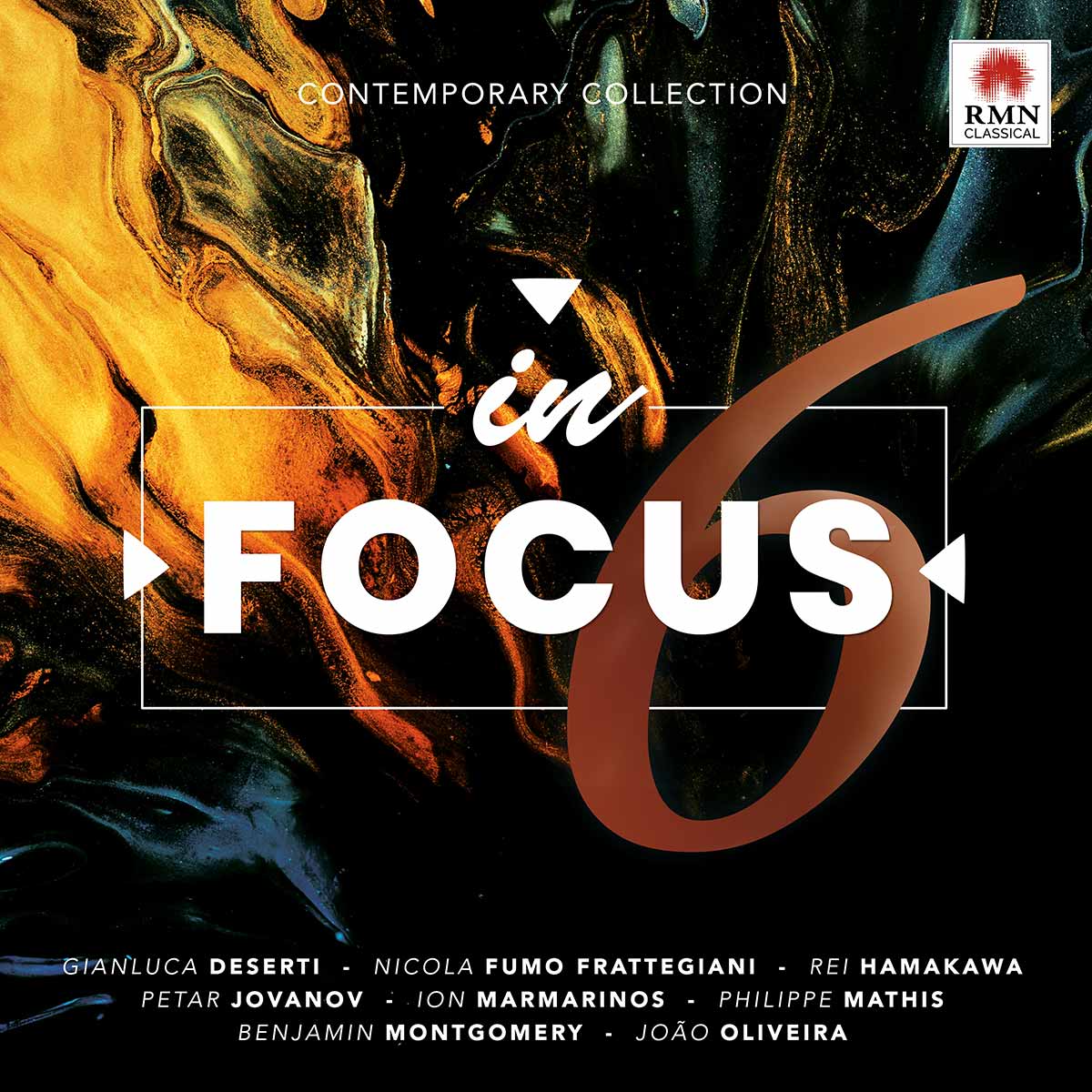MUSIC > In Focus 6

Title: In Focus 6
Release Date: 15 Jul 2022
Label: RMN Classical
Produced by R. Romano
Cover design by RMN Classical
Performed by
(in order of playlist)
01. Duo Sigma
02. Ales Lavrencic, Sebastiano Gubian
03 - 04. Hirofumi Uematsu
05. Riccardo Catria
06. Roadrunner Trio
07. Linda Jenkins, Alexander W. Ravitz, Heeyoung Choi
08. Philippe Mathis
09. Petar Jovanov, Shaun Stojkovski
In Focus 6 by Various Artists
| N. | Play | Title | Composer | Time |
| 01 | Absence-Mémoire | João Pedro Oliveira | 10:29 | |
| 02 | Ballade | Gianluca Deserti | 09:18 | |
| 03 | Fantasy on a Theme of Furusato (Hometown) for the Left Hand Alone | Rei Hamakawa | 03:44 | |
| 04 | Fantasy on a Theme of Happy Birthday To You for the Left Hand Alone | Rei Hamakawa | 04:19 | |
| 05 | Der hohle Zahn | Nicola Fumo Frattegiani | 04:42 | |
| 06 | Jeux de Lignes | Ion Marmarinos | 07:28 | |
| 07 | …Like Water | Benjamin Montgomery | 08:49 | |
| 08 | The Elves, The Lake of Saintirral | Philippe Mathis | 04:14 | |
| 09 | Voskresenie (Resurrection) | Petar Jovanov | 07:25 |
This piece was commissioned for a project that proposed integrating musical ideas or elements of the works of the Portuguese composer Jorge Peixinho to celebrate the 25th anniversary of his death, into a new original piece for cello, piano and electronics.
For this work, the composer chose the piano étude 1 (Mémoire d’une presence absente), a composition that marked the composer in his teenage years. Some ideas in this piece are transformed into new elements, creating the layout for "Absence-Mémoire" sound world.
The work is based on Furusato (Hometown), a well-known Japanese children's song written by Tatsuyuki Takano and composed by Teiichi Okano in 1914. The song is about reminiscing about the scenery of the mountains and fields of childhood from a distant place, and about the feelings of people who work hard and study away from their hometown.
The piece is broadly organised in three sections with the beginning focusing on the innocence of childhood and of playing in a hometown, the mid-section expressing the wistful loneliness of home after moving to the city and the last section building to a climax where a positive and powerful sense of love for the hometown ultimately fully manifests.
“Happy Birthday to You” is a well-known song that has been sung all over the world, and with many different arrangements. Many of them are created to celebrate someone's birthday, but in this version, the composer arranged the work and the main theme to celebrate life. The work is organised in seven different parts or 'variations.'
The first is inspired by the womb and concerned with the mystique. The melody is a high and low version of a section of the main theme.
The second part expresses the birth voice played using a technique devised by the composer (the hand makes a fist and is rotated on the keyboard to resemble the voice. The actual method is left to the discretion of the performer). Hirofumi Uematsu, who is playing the piece, decided how to imitate the birth voice after consulting with his wife, who recently gave birth.
The third part is childhood. The melody is straight and generally classical in nature.
The fourth part is adolescence and the mood is "frustration." The theme of “Happy Birthday to You” is partly in a minor key and manipulated to be slightly out of tune.
The fifth section is the mature age. Here we can find a fuller, more energetic and rhythmic theme.
The sixth part is late adulthood and the theme is "Sing softly" and the inner voice emerges as the main melody.
The final part is the end of life where the final chord, being the same as the chord in bar 1, represents reincarnation.
“Der hohle Zahn” is inspired by “Wings of Desire” by Wim Wenders filmed in 1987.
“Der hohle Zahn” (the hollow tooth) is how Berliners nicknamed Kaiser-Wilhelm-Gedächtniskirche church after it was bombed in 1943. It’s from the ruins of the bell tower, the hollow tooth, that Damiel the angel observes the movement of human life. The chaotic and magmatic flux of the souls corrupted by their own carnality.
The entire composition presents exclusively acoustic materials of the flugelhorn. The natural sound of the instrument symbolises the vitality and conflictual nature of the men while manipulated sounds represent the gaze of the angel which stares back at humanity, at the wideness of its vision. A few instrumental gestures become the few and essential reasons for the insatiable crisis of the man, and his recurrent mal de vivre.
The incipit and conclusion of the composition overlap, the circle is born and dies within the same instant and at the same point. When does time start? Where does space end?
The piece is inspired by the falling stars – meteorites - in the night sky. As seen from the earth, their short life is initially perceived as an illuminated line, which disappears in space. In reality, they are debris from a comet or asteroid, which disintegrate as they enter the atmosphere.
I combined these perspectives and pictured the night sky as a dome of stillness full of tiny scattered stars, colours, shapes of lights, and nebulae where flashes of lines are passing through.
The idea comes from the accordion’s wide range of sound qualities, colours and dynamics – later distributed to all instruments and sections; from chord structures and a relatively low register to lively melodic lines and a delicate high whistling.
The piece is organized in three sections: meteorites (birth and death of chords), journey in space (playfulness in fast dialogue) and entering the atmosphere where high register pitch sets in the accordion or clarinet interact with sets of cello harmonics to create layers of constantly overlapping harmonies…until they eventually disappear.
Almost any object or action can be said to be “like water,” resulting in an evocative interpretation. While too numerous to cover in a single work, this piece is a musical reflection on some of the things that water can be. Outside of its life-giving qualities, water has served as an immeasurable source of inspiration for humanity.
"I believe one of the reasons for this is the variety of forms that water can take and the breadth of feelings that we associate with them. From the mysterious depths of the ocean, to a gentle trickle of rain, to a still lake in the morning, to tumultuous river rapids, water’s ability to represent thoughts and emotions is limited only by our imagination. It almost always has some sense of motion or energy and begs us to ponder the story it tells. I realized that there are infinite possibilities to use water in figurative language." - B. Montgomery
Have you ever seen a road and stayed put wondering if you are to actually take it? Philippe Mathis, well known for his immersive works, will take you with this second opus of The Elves in the enchanting place of the legends and mythology of Northern Europe.
With this work, the composer seems to evocate the elf within to - maybe - find the answers to those questions that each of us has inside...
Voskresenie (2022) (Resurrection) operates with two musical themes - death and resurrection. The death theme is represented through chant-like singing to portray a kind of lament associated with morbid pain after the loss of life.
Tibetan singing bowls are struck and played to create a sense of calm and peace that follows after one ceases to exist. The tranquil state is portrayed through resonating pads and singing bowls that texturally evolve with a spontaneous rhythmic pattern that weaves in and out. The theme Resurrection is rhythmic with the textural build-up of timbres and spontaneous rhythm. Symbolically it can suggest the body is lifeless and dead while the spirit or energy source is born out of death. At the start, it smolders but then erupts and brings about the Resurrection.
The theme Resurrection works with odd time signatures such as 11/8, 7/8, and 9/8 derived from traditional Macedonian folk music. Musical instruments such as the kaval (wooden flute) and the gaida (bagpipe) are employed to enrich the sonic palette. A sense of "awakening" is expressed through low octaves on the piano that resemble a drone. A chord progression on an electronic synth complements the drone. This so-called "awakening" moment is heightened through orchestral cymbals and timpani to produce a powerful sonic transition into the resurrection theme.
Vocals develop into a rhythmic pattern that takes flight and drives the melody alongside the lyrical flute passage. The bagpipe plays a sad tune that sonically highlights pain, suffering, and injuries endured. It is a reflection of the burdens and torments inflicted through living. The piano takes on the role of playing blocked chords that dissipate instantly. In the blink of an eye, our life flashes before us. In other words, life is short.
In contrast, the 4/4 section has a repetitive and stringent melodic pattern on the piano that doubles on the flute. The kaval plays a solo followed by a return to the 11/8 section. A three-part voice harmony is heard that enhances the section by singing a melodic pattern. The bagpipe plays an interjecting passage in juxtaposition with the vocal harmonies. The melodic line of the bagpipe reveals that the torments inflicted on one are still repeated even in the present. The three-voiced melody sounds mighty and leads towards a direction that signifies "life goes on." The torment remains no matter how strong we think we are trying to suppress and ignore the past.
DISCOVER MORE MUSIC












